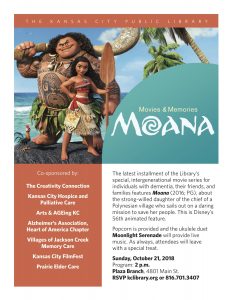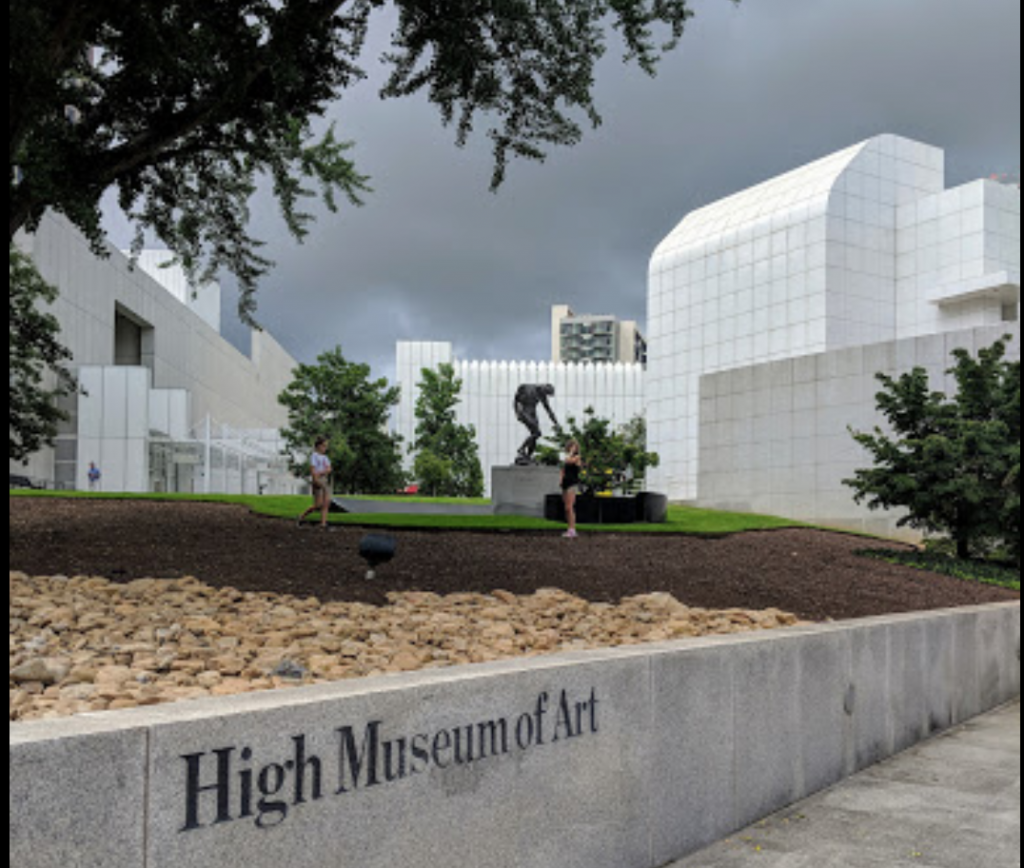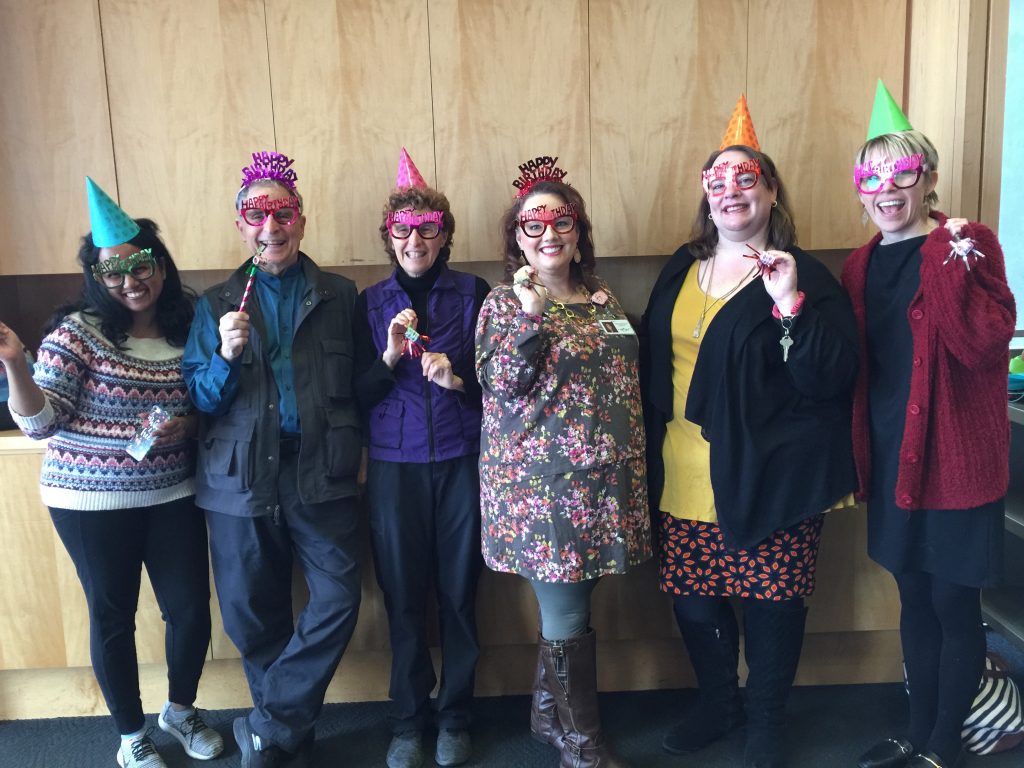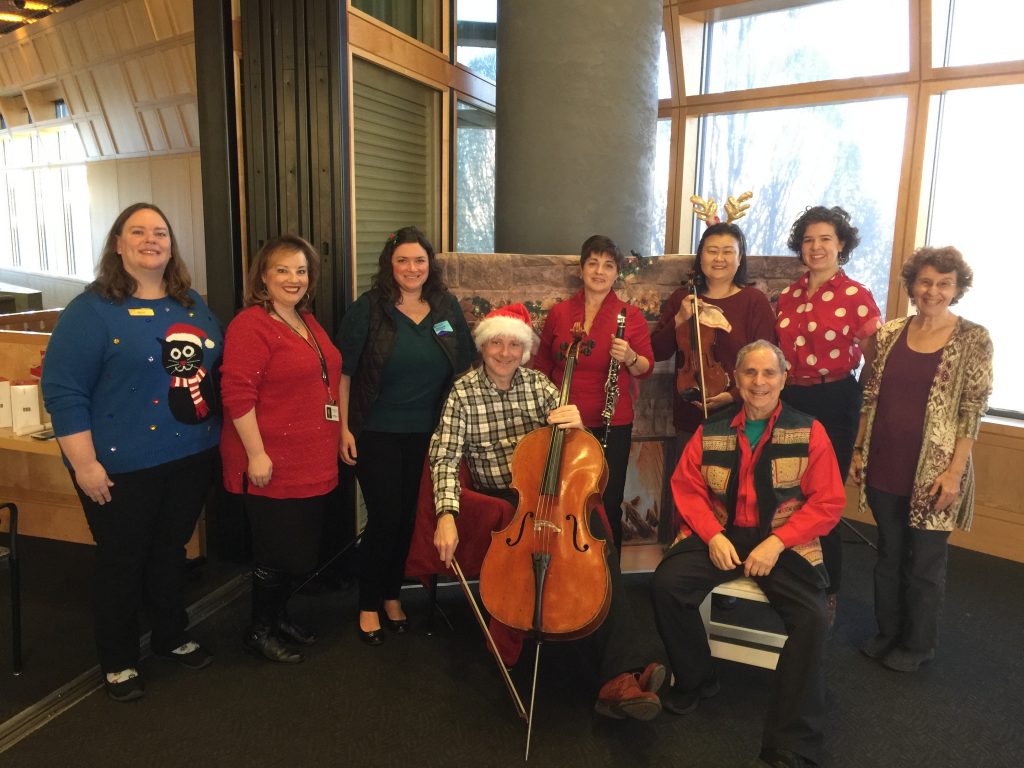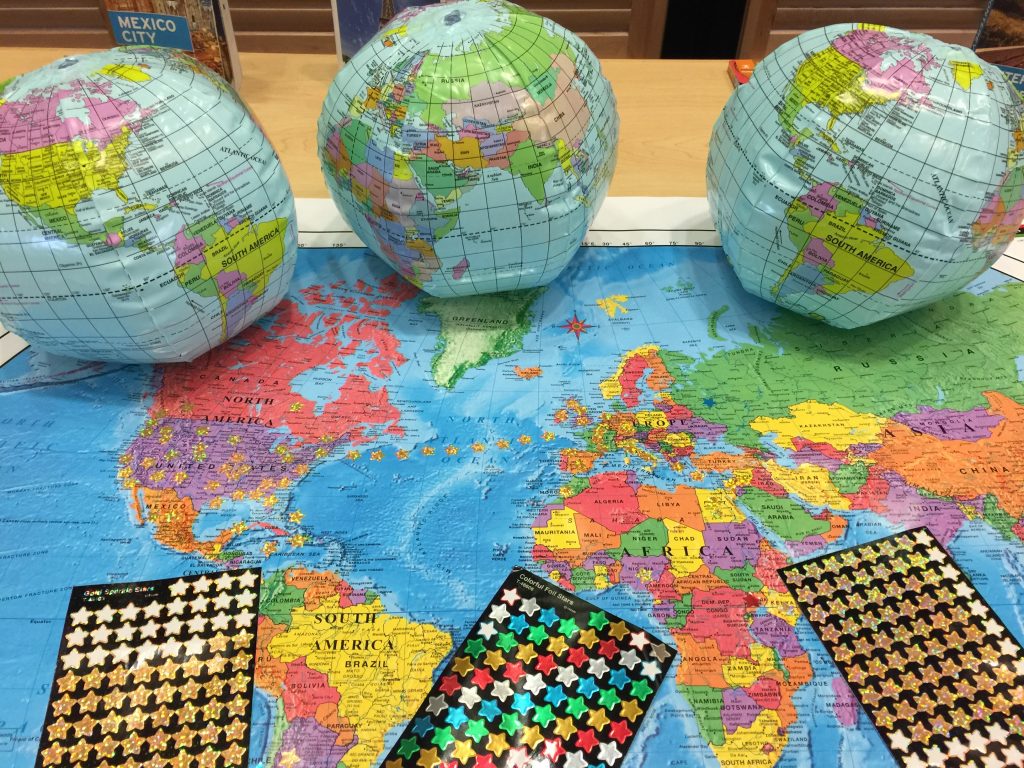The Arts
Some Enchanted Beautiful Morning: Movies & Memories Celebrates Inclusion
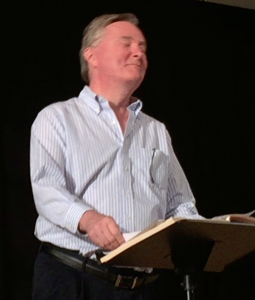 The buzz of conversation ceased as singer/actor Robert Gibby Brand stepped up to the microphone. His accompanist, pianist Robert Pherigo, played the opening bars of Oh, What a Beautiful Morning and Brand soared into the “Bright golden haze on the meadow.” Instantly the audience, ages two to 85 plus, was listening raptly. Brand continued his concert, inviting us to sing along on It’s a Long Way to Tipperary, and melting us with the Cole Porter classic Night and Day. Brand told us the story behind each song and left us wildly applauding after performing Some Enchanted Evening. It was some enchanted beautiful morning at the monthly KC Movies & Memories program.
The buzz of conversation ceased as singer/actor Robert Gibby Brand stepped up to the microphone. His accompanist, pianist Robert Pherigo, played the opening bars of Oh, What a Beautiful Morning and Brand soared into the “Bright golden haze on the meadow.” Instantly the audience, ages two to 85 plus, was listening raptly. Brand continued his concert, inviting us to sing along on It’s a Long Way to Tipperary, and melting us with the Cole Porter classic Night and Day. Brand told us the story behind each song and left us wildly applauding after performing Some Enchanted Evening. It was some enchanted beautiful morning at the monthly KC Movies & Memories program.
But the enchantment didn’t stop there. First we watched the Oscar nominated short, 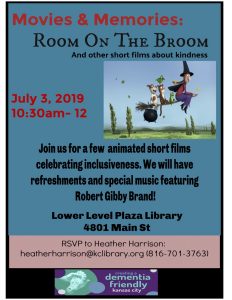 Room on the Broom, which illustrated the joys and challenges of inclusion in a most creative, playful, and poignant way.
Room on the Broom, which illustrated the joys and challenges of inclusion in a most creative, playful, and poignant way.
One of the characters said plaintively, “I am a bird, as green as can be. Is there room on the broom, for a bird like me?” The witch’s clingy cat captured that part in most of us that doesn’t want to share, that believes there is not enough. But the witch reminded us, “Yes, there is room.”
Afterwards we discussed the movie, asking who identified with the clingy cat. All of us had to raise our hands. Then we asked who identified with the witch, who welcomed everyone, and there was a large showing of hands. We also talked about favorite characters and what parts of the film we liked best.
 To finish our mini film-fest, we played an inspiring clip from a Mr. Rogers show, and showed Purl, an 8-minute Pixar film, about how our differences can enrich our lives.
To finish our mini film-fest, we played an inspiring clip from a Mr. Rogers show, and showed Purl, an 8-minute Pixar film, about how our differences can enrich our lives.
It was an inspiring program and everyone left uplifted and delightfully sated by our fresh-made popcorn and other treats.
For a taste of Some Enchanted Beautiful Morning, click here.
A big thanks to our volunteers, Sharon, Julie, and Pam, and to our generous hosts, The Plaza Library.
Want to continue the magic at home?
Room on the Broom is a 20-minute film that is fun for all ages, while being both entertaining and profound. You can easily generate open-ended questions and invite comments and conversation. We talked about, “If you were an animal, which animal would you like to be?” “Who did you identify with?” “What were your favorite parts of the movie?” “Have you ever not wanted to share?”
Want to continue the magic with us? Mark your calendars for the first Wednesday of each month at 10:30. Please join us for our next cafe and our next movie program. For more information, contact Deborah at creativity@pobox.com
Click to view informative and inspiring short videos on our YouTube channel
Deborah Shouse is the author of Connecting in the Land of Dementia: Creative Activities to Explore Together and Love in the Land of Dementia: Finding Hope in the Caregiver’s Journey.
Musing Together: Looking at Art Expands Skills, Increases Socialization, and Widens Horizons
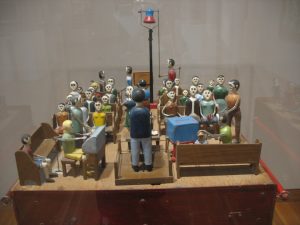 The group pauses in front of a large contemporary sculpture, depicting a preacher standing before his congregation at a small country church. They walk around the piece, noticing the pews, the organist, and the variety of parishioners, and chatting as they view. Then they settle into chairs and co-facilitator Esther Smith asks: “What is one word that comes to mind when you look at this piece of art.”
The group pauses in front of a large contemporary sculpture, depicting a preacher standing before his congregation at a small country church. They walk around the piece, noticing the pews, the organist, and the variety of parishioners, and chatting as they view. Then they settle into chairs and co-facilitator Esther Smith asks: “What is one word that comes to mind when you look at this piece of art.”
“Boring,’ says one woman.
“What makes it boring?” Esther asks.
“It brings me back to my childhood, when I was stuck in church for hours,” she answers. “I was so bored.”
A few others nod. Someone asks, “When was this made? Where is it from?” and the conversation about the art continues.
Every month at the High Museum in Atlanta, Georgia, Teaching Artist Esther Smith guides a group of care partners and people living with dementia on a 90-minute gallery exploration called Musings Together.
“It’s a light-hearted, interactive experience,” Esther says. “We go at a slow pace, seeing only three to four works each time. We want people to have a comfortable, personalized experience with art.”
 The open-ended conversation brings out people’s stories and ideas. Sitting in front of Giovanni Bellini’s Madona and Child, Esther asks, “What lines do you notice in this painting? Trace them in the air with your hand.”
The open-ended conversation brings out people’s stories and ideas. Sitting in front of Giovanni Bellini’s Madona and Child, Esther asks, “What lines do you notice in this painting? Trace them in the air with your hand.”
After people trace their lines, she asks, “What line was most interesting to you?” That question might lead into a discussion of what makes this painting different. Then Esther might invite the group to pose like the picture. She might say, “How would that baby’s head feel in your hand?”
“These simple prompts launch us into deep conversations,” Esther says. She and her team are experimenting with expanding the sensory experience, including bringing out oranges when they’re gazing at a still life of fruit and letting each guest hold and examine the orange. Esther also invites people to occasionally sketch an aspect of a drawing that appeals to them, using a drawing pad on a clipboard.
“ A number of our participants have never been regular museum-goers. Now they feel comfortable here and come more often,” Esther says. “Developing a new community of friends and an expanding interest in art enriches their lives.” #
Want to look at art with someone who is living with dementia?
If you’re visiting a museum, focus on a gallery with 3-4 large and interesting pieces. Ask a docent for advice, if needed. If you’re at home, give yourself plenty to time to comfortably view a few works of art on-line or in books.
- Bring a folding chair, so you can sit.
- Chose a time of day when your partner is energetic and the gallery is relatively quiet.
- Have fun just noticing the aspects of the piece. You might invite comments on colors, textures, familiar figures, objects that seem odd to you, and other aspects.
- Ask open-ended questions, such as, “What does this piece make you think of?” “What do you like about this piece?” “How do you think that main guy feels?”
When attention wanes, move onto something else, including a lovely coffee or tea break.
Click to view informative and inspiring short videos on our YouTube channel
Deborah Shouse is the author of Connecting in the Land of Dementia: Creative Activities to Explore Together and Love in the Land of Dementia: Finding Hope in the Caregiver’s Journey.
A Dream Came True at The Red Ballon Movies & Memories
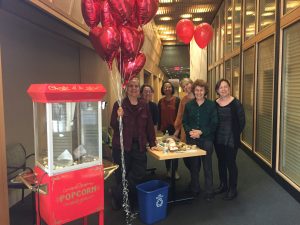 “I wish I had a red balloon,” one of our guests said, after the inspiring ending of the short film, The Red Balloon. Moments later, the dream came true. Each guest was offered a buoyant scarlet balloon, the magical symbol of a meaningful film.
“I wish I had a red balloon,” one of our guests said, after the inspiring ending of the short film, The Red Balloon. Moments later, the dream came true. Each guest was offered a buoyant scarlet balloon, the magical symbol of a meaningful film.
The Movies & Memories program now has a new time and date: the first Wednesday of each month from 10:30-12:00.
As guests enter the lower level of the 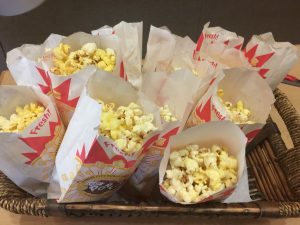 Plaza Library, they breathe in the enticing aroma of fresh popcorn. Soon, they are settled in comfortable chairs and munching on popcorn and cookies, while being serenaded. They sing along with Richelle Basgall, who engages them with fiddle, guitar, kazoo, and more. They tap their feet and clap their hands, belting out favorite folk songs and old standards, such as Ol’ Suzanna, Que Sera Sera, and I’ve Been Working on the Railroad.
Plaza Library, they breathe in the enticing aroma of fresh popcorn. Soon, they are settled in comfortable chairs and munching on popcorn and cookies, while being serenaded. They sing along with Richelle Basgall, who engages them with fiddle, guitar, kazoo, and more. They tap their feet and clap their hands, belting out favorite folk songs and old standards, such as Ol’ Suzanna, Que Sera Sera, and I’ve Been Working on the Railroad.
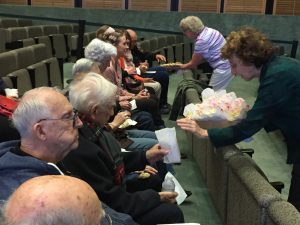 Then the lights lower and everyone watches intently as a young boy and his red balloon form a deep bond, and stick together, despite many obstacles. People were still talking about the movie as they and their balloons trail down the hallway, heading towards home.
Then the lights lower and everyone watches intently as a young boy and his red balloon form a deep bond, and stick together, despite many obstacles. People were still talking about the movie as they and their balloons trail down the hallway, heading towards home.
Get a taste of The Red Balloon movie event by clicking here.
Many thanks to our wonderful volunteers, including Sharon, Julie, and Pam. And special thanks to Sharon and Elizabeth from Stonecrest for bringing delicious snacks for us.
Our next movie experience is on July 3rd. Please join us for Room on the Broom, and other short films, a celebration of diversity. You’ll love the songs from Robert Gibby Brand, our featured musician.
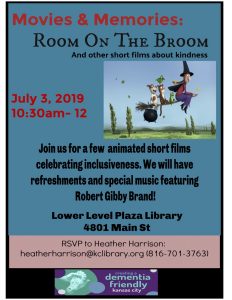
Click to view informative and inspiring short videos on our YouTube channel
Deborah Shouse is the author of Connecting in the Land of Dementia: Creative Activities to Explore Together and Love in the Land of Dementia: Finding Hope in the Caregiver’s Journey.
Rock Around the Library: Celebrating a Year of KC Memory Cafes
No one can sit still. Not when Little Richard, The Archies, or Dion are singing. It’s a Rock Around the Library: Celebrating a Year of the KC Memory Cafes. We are one-year-old this March and we’re celebrating with Musical Bingo by Carrieoke Productions. We’ve enjoyed ice cream and cake and we’re ready to roll, rock and roll, that is.
At the first note, one of our guest says, “Sugar, Sugar.” She’s right and a small group of us sings the literally saccharine 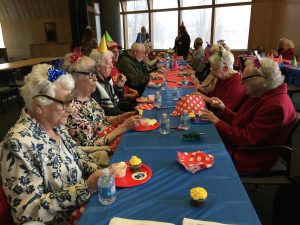 lyrics, “Sugar, ahh honey, honey, you are my candy girl…”
lyrics, “Sugar, ahh honey, honey, you are my candy girl…”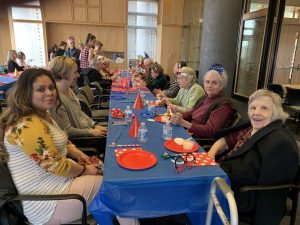
Within moments, all the care partners are dancing. We’re all helping each other find the songs on our Bingo sheets. We’re singing along when we know the lyrics and humming along when we don’t. We’re laughing.
When Carrie plays the Beach Boys’ tune, I Get Around, one guest says, “I wish I could get around.” Another chimes in, “Me too!”
For an hour, we Twist and Shout, warble Do You Want to Dance?, warn our neighbors not to “step on my Blue Suede Shoes,” and shake our heads over Run Around Sue. Those who win at musical bingo, and there are many of them, get to select a prize. 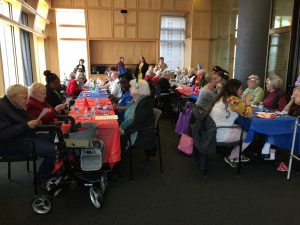
“It’s wonderful to see people blooming,” one care professional says.
And it’s equally wonderful to see the caregivers laughing, joking, dancing, encouraging, sharing, and helping us create This Magic Moment.
Click here to join the party:
Don’t miss our Magic Moment in April. The Kansas City Zoo is bringing some exotic and personable animals on April 16th.
Please join us at 10:30 on the lower level of the Plaza Library. Come early. Please share this information with anyone who might benefit.
Deborah Shouse is the author of Connecting in the Land of Dementia: Creative Activities to Explore Together and Love in the Land of Dementia: Finding Hope in the Caregiver’s Journey.
Art Invites Conversation
Teri Miller, with the Alzheimer’s Association Houston & Southeast Texas Chapter, has witnessed the power of how art invites conversation. As the Early Stage Program Manager, Teri collaborates with a variety of Houston’s arts and civic organizations.
“Going to cultural activities offers people a sense of normalcy and gives them a date to put on their calendars,” Teri says. “When they go with friends or care partners, they have an experience to discuss. Even people who say, ‘Oh, I don’t care for museums,’ usually have a great time.”
Sam is an example of someone who was surprised to enjoy the art gallery.
He attended one of Teri’s early stage support groups. His wife, who cared for him at home, went to the care partner’s group. Teri formed a partnership with the Houston Museum of Fine Arts and invited her early stage group to experience a tour. When he heard the invitation, Sam rolled his eyes and said, “I’ve never been to a museum and I’m not about to start now.”
But the next week, Sam signed up for the tour.
“What made you change your mind?” Teri asked.
“My wife really wanted to go. She does so much for me, I figured I’d do something for her.”
Teri expected Sam to sit back silently, arms folded over his chest, as the docent asked, “What does this painting make you think of? Has anyone ever been in a similar setting?” But to Teri’s surprise, Sam had opinions on each of the three pieces they discussed.
Sam told Teri, “At first, I didn’t want to go because I was worried I wouldn’t have anything meaningful to contribute. But I guess you don’t have to know anything about art to enjoy the museum.”
He and his wife talked about the experience all the way home. Discussing the paintings opened up chances to reminisce and connect. Plus the experience gave them something interesting to share with their grown children and visiting neighbors.
Like many art partnerships around the country, Teri was inspired by MOMA’s Meet Me art program for people living with dementia. The Houston museum benefitted from MOMA coming to train their docents. The program offers comprehensive guidelines for visiting a museum or viewing art at home.
Creative Sparks:
Many art galleries and museums offer special tours and events for people living with dementia. If you’re lucky enough to have such a tour available, take advantage of it.
To design your own museum tour:
- Think of a museum your partner likes. If feasible, buy postcards of some of their art or visit their on-line gallery together and ask your partner which pieces he prefers. That way, you can tailor the visit to his taste.
- Choose one or two rooms that feature his preferred art. Make sure one room has a place to sit.
- Use the paintings and sculptures as a catalyst for conversation. Ask open-ended questions, discussing the colors, people, and objects you both notice.
- If the museum has a restaurant or tearoom, treat yourselves to something delicious.
- Enjoy the sense of connection that comes from discussing art; there are no right or wrong answers, just interesting observations.
- To fashion a viewing experience at home:
- Select art books from the library or use your own personal collection.
- Choose works that portray emotion, tell a story or align with your partner’s background or interests.
- Ask open-ended questions that invite conversation, such as, “What does this make you think of?” and “What do you notice in this picture?” Have fun imagining what the people in the painting are thinking. Imagine their professions and whether they’re happy.
This is an excerpt from Connecting in the Land of Dementia: Creative Activities to Explore Together. Deborah also wrote Love in the Land of Dementia: Finding Hope in the Caregiver’s Journey.
Share Your Creative Arts Endeavors: An Opportunity for People who are Living with Dementia
I am honored to be part of the Arts Work Group at the Dementia Action Alliance, which is one of my favorite non-profits. Please share this information with those who might benefit. Warmly, Deborah
Dementia Action AllianceDementia Arts Fest 2019
Mike Belleville, 2018
The Dementia Arts Fest celebrates art made by persons living with dementia!
Call for Entries Deadline March 15, 2019
If you are a person living with dementia who engages in creative projects or you’re the leader of a creativity program for people living with dementia, we want to hear from you! You are invited to submit up to 3 pieces of art, ready to display – It’s an easy process to submit. This is what we need:
1. Photos of the artwork in JPEG, PDF, or PNG format. Label each image with your last name, the title.
2. A separate page:
Your name (artist’s name) and contact information.
List of your work with titles, dimensions, and media
3. Write down a brief description about how creating art impacts you and makes you feel. (around 200 words)
5. Email the above information to Karen Love at karenlove4@verizon.net.
Please let us know if you are submitting artwork on behalf of someone else.
Sale of Artwork
▪ Artwork accepted for the exhibition may be for sale, or may be marked as ‘NFS’ (not for sale). If the artwork is NFS, artists must include a prepaid return shipment label for UPS or Federal Express with their artwork shipment.
▪ If the artist’s work is sold, the Dementia Action Alliance [a 501(c)(3) charity] will receive 50% of the retail price set by the artist as a contribution.About the Dementia Action AllianceThe Dementia Action Alliance is a national non-profit organization of people living with dementia, care partners, dementia specialists and others making our nation a better place in which to live with dementia. www.daanow.org
Deborah Shouse is the author of Connecting in the Land of Dementia: Creative Activities to Explore Together and Love in the Land of Dementia: Finding Hope in the Caregiver’s Journey.
Santa and the Symphony Visit the KC Memory Cafe
 At our December Memory Cafe, Santa had an amazing pre-show- warm-up band: a trio from the Kansas City Symphony. Their renditions of familiar holiday tunes were musical works of art, filled with melodic flourishes and surprises. Our guests listened avidly. When Stephanie Brimhall, the Symphony’s Education Manager, led us in a singalong, everyone raised their voices and sang with heart and gusto. As our attendees finished decorating Christmas cookies with colorful icings, bright sprinkles, and little chunks of peppermint, we heard a jingling of bells and a booming, “Ho Ho Ho.” Santa had arrived, with a sack of treats.
At our December Memory Cafe, Santa had an amazing pre-show- warm-up band: a trio from the Kansas City Symphony. Their renditions of familiar holiday tunes were musical works of art, filled with melodic flourishes and surprises. Our guests listened avidly. When Stephanie Brimhall, the Symphony’s Education Manager, led us in a singalong, everyone raised their voices and sang with heart and gusto. As our attendees finished decorating Christmas cookies with colorful icings, bright sprinkles, and little chunks of peppermint, we heard a jingling of bells and a booming, “Ho Ho Ho.” Santa had arrived, with a sack of treats.
“How many of you have been good?” Santa asked and most of us raised our hands. Santa made the rounds, passing out sweet treats, courtesy of Russell Stover Chocolates, and wishing everyone a merry holiday.  Then he settled into a comfortable chair beside the backdrop of a scenic hearth. We all lined up to sit beside him and have our photos taken with the Great Claus. Santa warmly welcomed each person and everyone was just thrilled to be near him — and even more thrilled when Jennifer Walker’s remarkable little printer produced a wonderful photographic memento of the event.
Then he settled into a comfortable chair beside the backdrop of a scenic hearth. We all lined up to sit beside him and have our photos taken with the Great Claus. Santa warmly welcomed each person and everyone was just thrilled to be near him — and even more thrilled when Jennifer Walker’s remarkable little printer produced a wonderful photographic memento of the event.
At the end, Santa summed up the holiday spirit by sharing this message: “Peace for the world and good will for all people.”
We hope we can all continue this spirit of hope, sharing, and generosity throughout the new year.
Capture the cafe spirit for yourself by clicking on this short video:
Deborah Shouse is the author of Connecting in the Land of Dementia: Creative Activities to Explore Together and Love in the Land of Dementia: Finding Hope in the Caregiver’s Journey.
An Old-Fashioned Holiday
This old-fashioned holiday story from Love in the Land of Dementia: Finding Hope in the Caregiver’s Journey celebrates the spiritual aspects of living with dementia.
When I walk through the doors of the nursing home, I find my mother in her wheelchair, right in front of the medication cart, right behind the central nursing station, where nurses, delivery people, staff and family members congregate. Mom is bent over, her baby doll lying across her lap. When I walk up to her, I ratchet up my energy and widen my smile. I am preparing to clown her into a reaction.
Later my father will ask if I think she recognized me.
“No,” I will have to tell him. “She did not recognize me. But she did smile.”
The smile is important.
My hand waving and head bobbing does its work: Mom does smile, and I can tell she is in her own current version of a good mood.
“Music in the dining room,” the activity board reads, so I wheel her in that direction. An elderly man with a red and white trimmed Santa hat passes us in the hallway.
“Look Mom, there’s Santa,” I tell her.
Having been brought up Jewish, Mom never was all that enthralled with the Claus mythology and she has not changed.
A white-haired woman is in the dining room, busily setting up for the music program. Several patients are already gathered. The woman takes out a microphone, a boom box, an illuminated plastic snowman, and a small silver bell. I continue wheeling Mom down the far corridor, liking the sense of companionship I have from this movement.
As we stroll, a nurse carrying a plate of lettuce walks past us.
“She must have been a good mother,” she says, nodding at the way Mom is holding the baby. “She must still be a good mother.”
“She is,” I say.
I have never really said to my mom, “You were a good mother.”
Now I realize she was.
I can see that Mom is enjoying the ride. She loved movement when she was younger and was far more adventuresome than Dad when it came to airplanes, ski lifts, fast cars, and speedy boats. For her, biting breeze across the face was thrilling, not threatening. Until she became a mother, that is. Then she abandoned her pleasure in the heights and speed and concentrated on making sure we were slow, safe, and centered.
We roll back into the dining room just as the show is ready to start. The singer, Thelda, kicks off her shoes and presses play on the boom box. Above the cheerful sound track, she sings Jingle Bells. She dances across the room with the remnants of ballroom steps. She stops in front of Mom and sings right to her. She gets on her knees, so she can look into Mom’s eyes, and keeps singing. Mom notices her and smiles a little.
Thelda moves on, singing to each of the patients gathered around, so intent on making a connection that she often forgets the words.
“Is it all right for your Mom to come to Christmas holiday events?” the activity director had asked me, when Mom moved from the memory care into the skilled care portion of the nursing home.
“Yes, I’d like her to go to any activities. She likes the extra energy.”
I think Mom would approve of my decision, even though she has never celebrated Christmas. Growing up, her immigrant mother held on to the Jewish spirit of her home, kneading dough for Friday evening challah, observing each holiday and prayer period in her own way. Some orthodox women followed the religious law that commanded a small piece of the dough be burned as an offering to God. My grandmother was poor; she did not believe in burning good food, regardless of tradition. So she sacrificed a portion of the dough to her youngest daughter, my mother Fran. She created a “bread tail,” leftover dough that she smeared with butter and sprinkled with sugar and baked. When Mom used to talk about her mother, she always mentioned this special treat.
Even when I was growing up, and we were the only Jewish family in our neighborhood, my mother still did not sing Christmas songs. She did not willingly go to Christmas parties. She let the holiday rush by her, like a large train, whooshing past, ruffling her hair and leaving her behind.
Now, I am singing Christmas carols to my Mom for the first time. She is smiling, though really not at me. But I am sitting beside her while she is smiling and that makes me happy. She has moved beyond the place where the religions are different, beyond the place where she wants to separate the dough and make a sacrifice for tradition. Her new tradition is anyone who can make her smile.
With each song, from White Christmas, to Silver Bells, to Frosty the Snowman, Thelda moves back to Mom, tapping her, nudging her, shaking a bell almost in her face, acting sillier and sillier. Each time, Mom lifts her head and widens her mouth for a second.
For her finale, Thelda puts on a big red nose and sings Rudolph. When she dances in front of Mom with that nose, Mom laughs. For several minutes, Mom stays fixated on the scarlet nose, her face a miracle in pure enjoyment. I laugh too, so delighted to see Mom engaged and absorbed. Then, Thelda dances away and Mom’s face glazes back over.
Two weeks from now, I will bring a menorah and candles into my mother’s room. My father and I will have a short Chanukah ceremony with Mom. She will pick at the shiny paper covering the Chanukah gelt (chocolate candy disguised as money). She will slump over in her chair. But she will come back to life when she sees me, her only daughter, wearing a big red nose as I light the menorah.
Deborah Shouse is the author of Connecting in the Land of Dementia: Creative Activities to Explore Together and Love in the Land of Dementia: Finding Hope in the Caregiver’s Journey.
Dementia Arts to Draw us Together
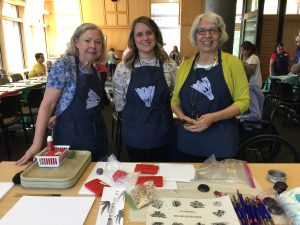 September’s Memory Cafe featured a lively team of educators from the Nelson-Atkins Museum of Art. Using the arts to draw us together, they showed us the Chinese art form of painting pictures of bamboo. About fifty of us gathered in the the library’s spacious lower level. Colorful plastic cloths covered our tables, making it easy to distinguish our drawing paper and painting supplies.
September’s Memory Cafe featured a lively team of educators from the Nelson-Atkins Museum of Art. Using the arts to draw us together, they showed us the Chinese art form of painting pictures of bamboo. About fifty of us gathered in the the library’s spacious lower level. Colorful plastic cloths covered our tables, making it easy to distinguish our drawing paper and painting supplies. 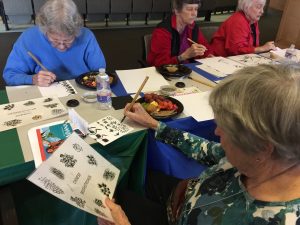 All of us eagerly dipped our special bamboo brushes into the ebony paint and made short pushing movements, replicating segments of the plant’s stalk. Then our educators showed us drawings of bamboo foliage and we experimented with wispy thin lines of leaves.
All of us eagerly dipped our special bamboo brushes into the ebony paint and made short pushing movements, replicating segments of the plant’s stalk. Then our educators showed us drawings of bamboo foliage and we experimented with wispy thin lines of leaves.
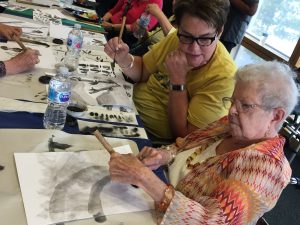 Our common ground continued as our teacher said, “Now, we’re going to pass out large sheets of paper.” We all oohed and aahed and let our strokes grow larger and more confident. At the end, each person created a design in a small wedge of clay, pressed the clay into a red stamp pad, and adorned the painting with our own personal “signature.”
Our common ground continued as our teacher said, “Now, we’re going to pass out large sheets of paper.” We all oohed and aahed and let our strokes grow larger and more confident. At the end, each person created a design in a small wedge of clay, pressed the clay into a red stamp pad, and adorned the painting with our own personal “signature.”• To add extra meaning, connect the artistic activity with something in your partner’s past.
• Invite an intergenerational mixture of artists, from children, grandchildren, art students, and volunteers to join your partner and add encouragement. 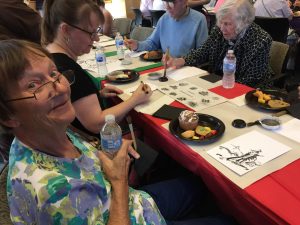
• Create a variety of art-related activities, including visiting galleries or looking at pictures from magazines, as well as painting, drawing or various media.

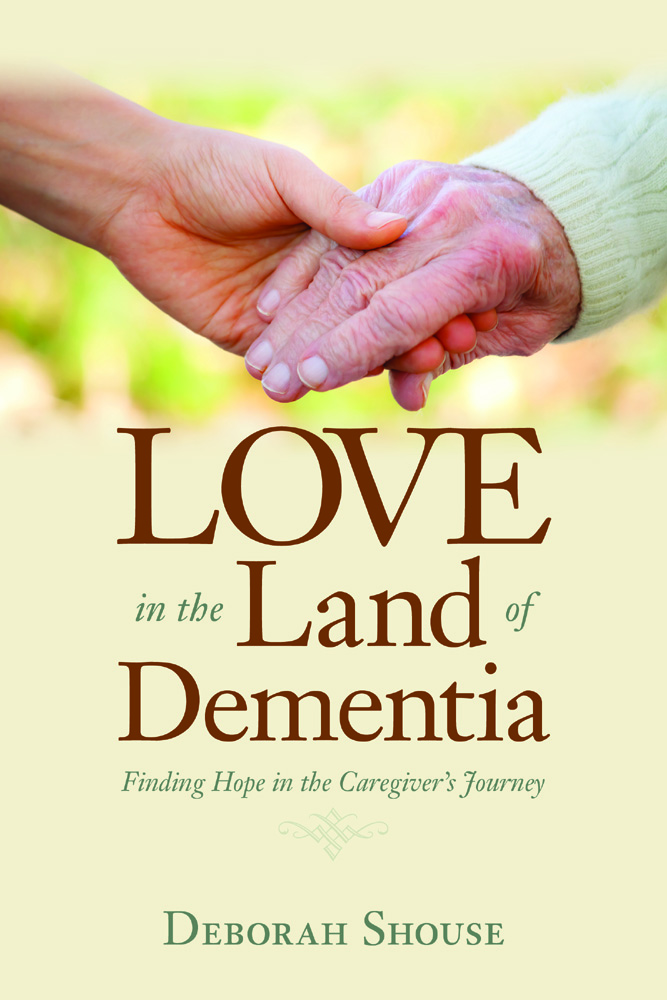
Movies and Memories: Traveling the World Without Leaving Kansas City:
“I’ve traveled the world. Our family moved a lot when we were young,” one of our guests told us, at our August Movies and Memories program. She and her husband bent over our world map and stuck stars on some of the many places 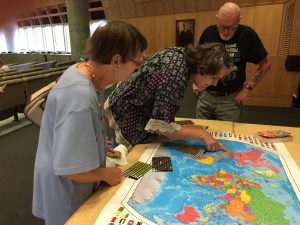 they’d lived. Another guest sighed when he looked at the map and saw Vietnam. He had served in the military there. A couple talked about living in Berlin when the Wall came down.
they’d lived. Another guest sighed when he looked at the map and saw Vietnam. He had served in the military there. A couple talked about living in Berlin when the Wall came down.
Our Movies and Memories travel films included forays into Paris, Iceland, Capetown, and Seoul.
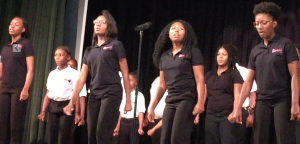 “It was relaxing just watching the scenes from Paris,” said Ah’Lee Robinson, director of the Kansas City Boys and Girls Choirs. He and his singers treated us to an inspiring concert, warming us up for the films.
“It was relaxing just watching the scenes from Paris,” said Ah’Lee Robinson, director of the Kansas City Boys and Girls Choirs. He and his singers treated us to an inspiring concert, warming us up for the films.
“Oh dear, now I want to go to Iceland,” another guest said.
In between clips, we passed around exotic spices for everyone to smell. At the end of the movies and memories adventure, everyone took home a special “Passport” booklet, created by the library’s Emily Cox, so they could record impressions and memories. To experience the event, click here.
Here are some passport questions to discuss at home: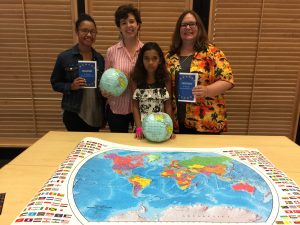
Share some travel memories.
What is one of the most beautiful places you’ve ever visited?
What’s the farthest you’ve ever traveled?
What country has the best food?
How many of the US states have you visited?
Thanks to our wonderful volunteers, Sharon and Julie, who brighten our events by bringing treats, making popcorn, and making everyone feel so at home.
Thanks to Craig Eichelman, State Director, AARP, for helping us spread the word about this program.
 We are so grateful for the continuing support from the Kansas City Public Library. They are amazing champions for people who are living with dementia and their care partners. They also provide scholarships for hard-working people whose higher education has been interrupted by life circumstances. Their community programs benefit early readers, job seekers, and people who are new to KC. Ron and I use their books and other services every week!
We are so grateful for the continuing support from the Kansas City Public Library. They are amazing champions for people who are living with dementia and their care partners. They also provide scholarships for hard-working people whose higher education has been interrupted by life circumstances. Their community programs benefit early readers, job seekers, and people who are new to KC. Ron and I use their books and other services every week!
Please join us for our next adventure — Moana. This movie is so inspiring and great for all ages.
